Economic Impact of Katrina
This article from AP and Yahoo is typical of what I have seen so far of the economic projections from Katrina...
Katrina Expected to Disrupt Economy
By Jeannine Aversa, AP Economics Writer
Surging Energy Prices, Business Disruptions From Hurricane Katrina Threaten to Slow Economy
WASHINGTON (AP) -- Surging energy prices and business disruptions from Hurricane Katrina, likely the costliest natural disaster in U.S. history, threaten to slow what has been a steadily expanding economy.
While the damage has yet to be fully assessed, economists and other experts believe the disaster will rack up insured losses of up to $25 billion. That would surpass the $21 billion (in inflation-adjusted losses) stemming from Hurricane Andrew in 1992, analysts said.
"This will be one of the -- if not the -- biggest single event in terms of insured losses in U.S. history," said Julie Rochman, spokeswoman at the American Insurance Association.
Read more of this article...I think there is also another way to look at it. There will be billions of disaster relief money flooding into Louisiana, Alabama and Mississippi. Where will all of that money be spent?
Here are a few places that may have a good quarter or so...
Home Depot HD up only 1.5% this week.
Lowes LOW
Tractor Supply TSCO I see a big boost to revenue.
Also furniture: Haverty HVTA, Aaron Rents RNT, Basset Furniture BSET, Chromcraft Revington CRC, Dorrell Ind DIIB, Furniture Brands FBN...
Also names like Mohawk Industries, MHK for carpet and flooring. There must be other good carpet companies. What's the first thing you replace after a flood?
Premanufactured homes:
CAVALIER HOMES INC (CAV)
MODTECH HOLDINGS INC (MODT) This will be a fast mover.
SKYLINE CORP (SKY) volatile
CENTEX CORP (CTX)
CHAMPION ENTERPRISES INC (CHB)
For the next few quarters anyone who can fill the demand for temporary buildings in the washed-out areas will make money. Longer term, home builders will have plenty of work. Luckily, there are alot of carpenters along this area of the gulf coast. Anyone who wants to swing a hammer will be able to get a job here.
So, with $25 billion of insured losses there will be alot of purchases of replacement homes and stuff. While this may be a drag on the economy in some ways, it will be a boost in others.
Back From The Beach
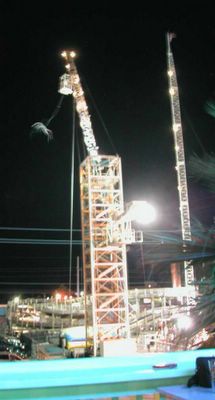
I am back from the beach but it is going to take awhile to catch up.
In the meantime here's a picture from
Louie's Backyard of a bungee jumper.
Malaysia Joins Space Race
Destination moon by 2020
BY ZULKIFLI ABD RAHMAN
KUANTAN: Malaysia hopes to take the giant leap by sending its first man to the moon by 2020.
And Malaysians must not think of this as impossible, says Science, Technology and Innovation Minister Datuk Seri Dr Jamaluddin Jarjis.
His ministry would forward this proposal to the Cabinet soon, he said, adding that he believed Malaysians wanted to see their countryman setting foot on the moon.
Malaysia’s First Astronaut Programme to the International Outer Space Station in 2007 would lay the foundation for the ambitious mission, he told reporters here yesterday.
Dr Jamaluddin said eight people would be short-listed for the final tests in Russia. One of the last two candidates will be the astronaut to go into space with the Russians.
Russia is helping Malaysia send its first astronaut to space as part of a deal following Malaysia’s purchase of 18 Sukhoi military jets.
Destination moon by 2020
Prospecting
I'm off to the
beach for a few days.
I'll be back Aug. 31.
Prospector
Why did the chicken cross the road?
Magnetic Fields
Chickens orient using a magnetic compassIn the new work, researchers including Rafael Freire from the University of New England (Australia), Wolfgang Wiltschko and Roswitha Wiltschko from the University of Frankfurt, Germany, and Ursula Munro from the University of Technology in Sydney, demonstrated for the first time that birds could be trained to respond to a magnetic direction. The researchers trained domestic chicks to find an object that was associated with imprinting and was behind one of four screens placed in the corners of a square apparatus, and, crucially, showed that the chicks' direction of movement during searching for the hidden imprinting stimulus was influenced by shifting the magnetic field.
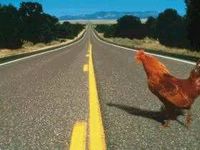
One important difference between this work and earlier attempts to train birds is that the researchers used a social stimulus to train the birds, whereas most previous attempts have used food as the reward. The authors of the study hypothesize that in nature, birds do not use magnetic signals to find food, and tests involving such a response may be alien to them.
The work also shows that the ability to orient with magnetic cues is not only present in an ancient avian lineage dating back to the cretaceous period, but has also been retained in a nonmigrating bird after thousands of years of domestication.
Chickens orient using a magnetic compass
Gambling Monkeys
DURHAM, N.C. -- Duke University Medical Center neurobiologists have pinpointed circuitry in the brains of monkeys that assesses the level of risk in a given action. Their findings -- gained from experiments in which they gave the monkeys a chance to gamble to receive juice rewards -- could give insights into why humans compulsively engage in risky behaviors, including gambling, unsafe sex, drug use and overeating.
The researchers, Michael Platt, M.D., and Allison McCoy
To their surprise, the monkeys overwhelmingly preferred to gamble by looking at the risky target. This preference held, regardless of whether the scientists made the risky target reward more variable, or whether the monkeys had received more or less fruit juice during the course of the day.
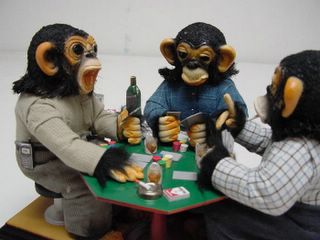
Poker Monkeys
Even when the researchers subjected the monkeys to a string of "losses," the high of a "win" appeared to keep them going, said Platt.
"While it's always dangerous to anthropomorphize," said Platt,
we still do it. Maybe training a monkey to anthropomorphize would help explain it."We don't think the posterior cingulate cortex is by any means the only area that's important for assessing risk," but it does sound almost as funny as "poker monkeys."
What's more, said Platt, the studies with monkeys can guide studies in mice, but he does not think gambling mice will be nearly as funny as the poker monkeys.
" it seemed as if these monkeys got a high out of getting a big reward that obliterated any memory of all the losses that they would experience following that big reward," said Platt
This whole experiment is probably just another way to use wild animals to get around the laws and open more casinos.|| DukeMedNews || Gambling Monkeys Give Insight Into Neural Machinery Of Risk
New Blog Toy
Here's a new toy for blogs.
gvisit.com will plot recent blog visitors using google maps.
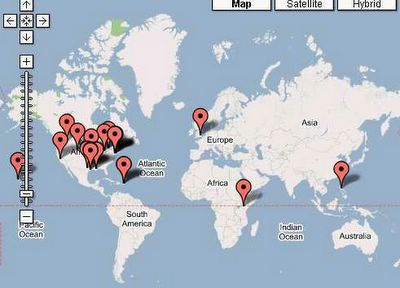 Link to the map for Opportunity Prospector.
Link to the map for Opportunity Prospector.If you're looking for yourself on the map you may have to wait. It seems to take a few hours before it is updtaed.
Latest Beer News
Beer that makes you well...Ladybird Bio Beer was launched in India. The beer includes aloe vera extracts which, the brewers claim, will help with bio-availability of vitamins. The beer will protect the liver from the bad effects of alcohol.
Nutraceutical? Swig-a-ceutical. Next - a beer that is good for your heart and a weight-loss beer.
This beer is 'good for you' | The Other Side | Breaking News 24/7 - NEWS.com.au (18-08-2005)Beer that makes you, well, drunk...Boston brewery Samual Adams has launched a very premium Utopias beer. The beer boasts 25% alcohol, six times stronger than your average beer and twice the punch of wine.

Maybe popular with the most enthusiastic embiber but as Ananova reports,"And at £56 a bottle, Samuel Adams Utopias is also among the world's most expensive."
Ananova
Simplifying Synthetic Life
A follow-up to the post about
synthetic biology...
An article in Houston Chronicle describes the changes to the science.
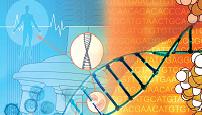
A
Life Engineering Symposium begins today at
University of California San Francisco hosted by
qb3 California Institute for Quantitative Biomedical Research.Reader Chris H has pointed out how easily this science could develop into biological
artifacturing.
Once the process is perfected then the invention of new life will be a matter of coming up with with the idea for the design of a new creature. The work will be in the design and software side rather than in the mechanics of building the organism.

Seeking order in chaos of genetic engineering
Synthetic biology is expanding as fears grow of potential misuse
By PAUL ELIAS
Associated Press
They're mixing, matching and stacking DNA's chemical components like microscopic Legos in an effort to make biologically based computers, medicines and alternative energy sources. The rapidly expanding field is confounding the taxonomists' centuries-old system of classifying species and raising concerns about the technology's potential for misuse.
So a new breed of biologists is attempting to bring order to the hit-and-miss chaos of genetic engineering by bringing to biotechnology the same engineering strategies used to build computers and bridges.
The idea is to separate cells into their fundamental components and then rebuild new organisms, a much more complex way of genetic engineering.
Already, synthetic biologists have created a polio virus and another smaller virus by stitching together individual genes purchased from biotechnology companies.
In Israel, scientists have created the world's smallest computer by engineering DNA to carry out math functions.
J. Craig Venter, a scientist who mapped the human genome, announced last month that he intends to string together genes to create from scratch novel organisms that can produce alternative fuels such as hydrogen and ethanol.
"We're building parts that can be assembled into devices and devices that can be turned into systems," said Jay Keasling, head of the Lawrence Berkeley National Laboratory's Berkeley synthetic biology department, which was created last year.
Keasling, who doubles as a chemical engineering professor at the University of California, Berkeley, hopes to create never-before-seen living molecules by fusing genes from the three species — a new breed of bacteria capable of spitting out malaria-fighting artemisinin, a chemical now found only in small traces in the wormwood plant.
But national security experts and even synthetic biologists themselves fret that rogue scientists or "biohackers" could create new biological weapons — like deadly viruses that lack natural foes. They also worry about innocent mistakes — organisms that could potentially create havoc if allowed to reproduce outside the lab.
complete article at...
HoustonChronicle.com - Seeking order in chaos of genetic engineering
Rewilding of America
Cornell University graduate student
Josh Donlan and advisor
Harry Greene have proposed that large areas of the North American grasslands be relinquished to African and Asian predatory animals.
The authors say that that the release of elephants, cheetahs, camels etc could revitilize the rural economies of the midwest with eco-tourists.
Their objective is to return the areas to the ecosystems of 13,000 years ago - before humans came in and killed all of the native animals and reorganized the whole ecosystem.
The parks would also preserve the exotic animals from extinction in their lands.
I can't help but suspect that this is some kind of a plan to let the land revert back to the native state so that there is some legal way to open casinos. "Exotic Animal Park and Casino"
To test the concept of "rewilding" they plan to do a pilot study by releasing tortoises in New Mexico. Uh, do you think wild turtles will be an accurate test of the idea of letting elephants and tigers run wild?
Donlan expects that there will be some resistance from citizens to letting wild animals loose in their neighborhoods. He says, "There are going to have to be some major attitude shifts. That includes realizing predation is a natural role, and that people are going to have to take precautions."
I think we already may realize that "predation is a natural role." That's why all the dangerous animals are gone! Humans - top of the food chain? - you know, the bad guys on the block? I think our predation of dangerous species is quite natural - it's how we take precautions.
CU researchers propose rewilding
"Nintendogs" the Next Best Thing To a Real Pup?
Personally, I don't think I would fall for an animated dog in a handheld game console. One may need to already have an emotional bond with the console to fully appreciate the cuteness of this development.By Matt Slagle
From DigiMon to Tamagotchi, there are dozens of choices for the virtual pet lover.
The latest, "Nintendogs," ($30, rated E) debuts in the United States next week, exclusively for the Nintendo DS handheld game machine.
Available in Japan for months, "Nintendogs" is a lifelike digital rendering of perhaps the most universally admired of all domestic animals: puppies.
It's a superb example of just how interactive the DS can be with its microphone, built-in wireless and two screens -- one of them touch sensitive.
The dogs are shown in 3D and do an amazing job of mimicking the real thing: they'll sniff around, pant and bark when excited. (They even engage in some unpleasant but necessary business).
The DS touch screen and microphone are ingeniously used. You can "rub" your pet by stroking it on the bottom screen.
You teach your pet various tricks by speaking into the microphone, then rewarding your dog with a rub on the back or behind the ear.
"Nintendogs" is real time, so it's important to frequently check on your pup.
I neglected Huggy for two days and returned to find him thirsty, hungry and in no mood to play.
Guilt-ridden, I gave him a bowl of food and water, which he quickly gulped down. He then curled up and took a nap.
Checking on Huggy isn't the chore I thought it would be -- it's fun teaching him how to beg, shake, play catch and take walks around the virtual block.
After only a few weeks, I've already formed an emotional attachment with my pixelated pup.
"Nintendogs" the Next Best Thing To a Real Pup
Urban Dispersion
Just like Christo's Gates except it won't attract as many tourists. And you need a special gas detector to see it. Oh, and it simulates a bio-terror attack. And I guess the artists do not really see the artistry in the project.
But the
Urban Dispersion Program could be the name of a tres cool line of clothing.
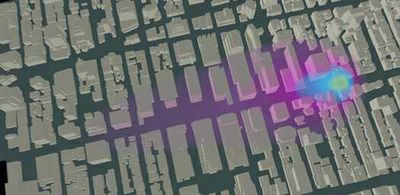
NYC will play host to odorless invisible gasses racing through the urban canyons. For three weeks in August gasses will be released and tracked throught the city.
According to
USA Today along with permanent sensors mounted on rooftops, a team of interns will be sent out to chase the invisible cloud. Of course, send the interns. Interns will do anything.
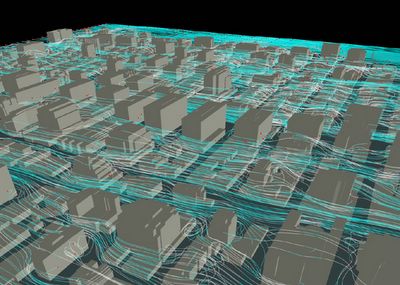
The test gasses are probably non-toxic but who really knows.
freesound
The Freesound Project aims to create a huge collaborative database of audio snippets, samples, recordings, bleeps, ... released under the Creative Commons Sampling Plus License. The Freesound Project provides new and interesting ways of accessing these samples, allowing users to
* browse the sounds in new ways using keywords, a "sounds-like" type of browsing and more
* up and download sounds to and from the database, under the same creative commons license
* interact with fellow sound-artists!
 freesound :: home page
freesound :: home page
Creating Life From Scratch
Startup: Designer Life
By Corie Lok
Last year, some 250 engineers, computer scientists, and biologists gathered at MIT for the first conference in a new field called synthetic biology. Their common goal: designing and building from scratch artificial biological systems such as cells or microorganisms that can do anything from producing drugs to cleaning up pollution.
Just a few months after the conference, some of the researchers founded a synthetic-biology startup called Codon Devices to provide those tools. With $13 million in venture capital funding, Codon is developing high-speed, low-cost DNA synthesis technology that could make synthetic biology a reality.
Since synthetic biologists engineer genomes from scratch, instead of modifying naturally occurring ones, they should be able to create proteins and cells with novel and complex capabilities. Synthetic biologists say they want to design and build genomes in the same way that electrical engineers make integrated circuits.
Within the next two years, Codon's technology should reduce the time and cost of synthesizing DNA to about one-hundredth to one-thousandth of their current rates.
Startup: Designer Life
Origami Food
In an effort to increase consumption of fruits and vegetables the U.S. Agricultural Research Service is studying how to turn the foods into palatable paper. What a delicious idea !
No really, it's not so much like paper as it is like seaweed.
My mouth is really watering now.Coming Soon—Broccoli and Peach 'Seaweeds'
Janet Raloff
These new thin vegetable and fruit films can be laced with spices or fortified with vitamins and other beneficial plant-derived compounds. ...explains team leader Tara McHugh, a food scientist with the
U.S. Agricultural Research Service...
 Origami Foods
Origami Foods, which is partnering with McHugh's team in the development of these new films, has an additional goal. It's to bring Japanese-style cuisine to palates that don't find traditional nori products appealing, explains company president, Matthew de Bord.
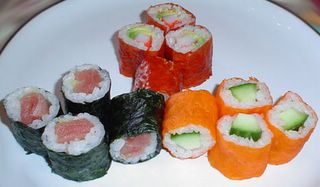 Food for Thought: Coming Soon—Broccoli and Peach 'Seaweeds', Science News Online, Aug. 6, 2005
Food for Thought: Coming Soon—Broccoli and Peach 'Seaweeds', Science News Online, Aug. 6, 2005
Mindball
Mindball® is an experience product, a game where two players control a ball with their brain waves. The player being most relaxed wins the game. The brain waves are detected by sensors attached to the headbands. The sensors (electrodes) are connected to a biosensor system. The biosensor system, registers the electrical activity in the brain – so called EEG.

The player being most relaxed makes the ball roll over to the opponent´s goal, with his brain waves as only aid, and thereby wins the game.
Available from the website. Only US $18,000 and up.
Interactive Productline AB
Too Many Planets Numb the Mind - New York Times
I usually do not post total stupidity but this editorial from NYT just cracked me up.
Their argument is that since a new planet has been found in our solar system and we have all learned in "grade school lessons" that there are nine planets in the system, then Pluto should no longer be considered a planet. Too many planets is too hard to remember and as the tagline says, "Too Many Planets Numb the Mind" ... of NYT editors.
Here's a quote:
Our own preference is to take a cleaner way out by dropping Pluto from the planetary ranks. Scientists may well discover many more ice balls bigger than Pluto, and it's a safe bet that few in our culture want to memorize the names of 20 or more planets. Far better to downgrade Pluto to the status of an icy sphere that was once mistakenly deemed a planet because we had not yet discovered its compatriots on the dark fringes of the solar system.
I do not know if they are kidding. Surely the editors of NYT don't think that anyone cares what they believe in the great planet-definition debate rocking America.
Too Many Planets Numb the Mind - New York Times















